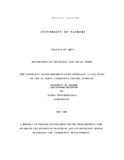| dc.description.abstract | The study focused on the Community Based Rehabilitation Approach as used by the St.
John's Community Centre to address the needs of its recipients in the Pumwani
administrative division. As the name suggests, the Community Based Rehabilitation
Approach involved the empowering of vulnerable children at the community level, while
at the same time exploring all possibilities of empowering their families to carry out their
responsibilities of bringing up children.
The approach designed strategies that enhanced the capacity of communities: families
and children cope with the conditions that contribute to the movement of the children
from homes to the streets. It addressed the familial, situational, economic and
psychosocial factors that predisposed the children to street life involvement.
The broad objective of the research was to evaluate the Community Based Rehabilitation
Approach used by riie St John's Community Centre. The specific objectives were: to
study and understand the content of the approach, to assess the implementation strategy
of the approach, to establish challenges faced by the approach and record the measures
against these challenges and lastly to collect and compile the stakeholders' perception in
regard to the outcome of the community based rehabilitation program.
The theories that informed this research were Herbert Blumer's symbolic interactionism
theory and Adele Clarke's situational analysis theory.
The research used the purposive sampling technique and a total of 50 respondents were
interviewed. The main sources of data were secondary and primary. Secondary data was
from: Books. Journals. Websites, Research reports and other projects running community
based rehabilitation programs while the primary data was from direct observation.
Interviews and the Focus Group Discussions.
From the findings, a majority of the children (75%) stated that they were using their
leisure | en_US |

